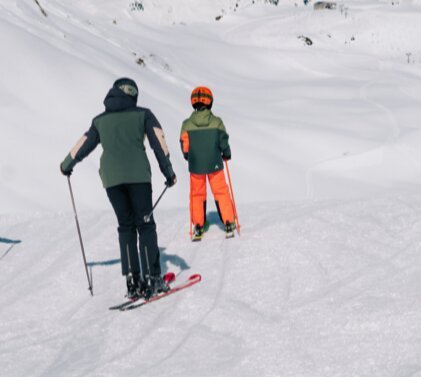
For many winter sports fans, a skiing holiday is the highlight of the year - even if transporting luggage can always be a challenge. The most important thing is to transport your ski equipment safely!
In this article, we'll give you some tips on packing your ski equipment and then look at the special features of transporting it by car, train or plane.
Luggage ideas for travelling with ski equipment at a glance
Always make sure that your ski equipment is dry before packing. Otherwise, high humidity in the bag can cause the edges to start rusting. Annoying, because in this case your relaxing winter holiday starts with a ski service.
Is your equipment dry and clean? Then it's time to start packing! Whether you're travelling by car or plane:
- The choice of ski bag: the options seem limitless - from a simple ski bag to a ski bag with wheels, there are a variety of models in all sizes. Let's take a look at some of the options:
- Carrier bags: If you regularly carry your skis from the cellar to the car and put them in the rear boot or roof box, you could opt for an inexpensive, unpadded ski bag with a shoulder strap. It is easy to put over your shoulders and the material of the bag prevents the sharp edges from damaging the interior during transport.
- Ski bag with wheels: If you want to travel medium to long distances with all your ski equipment, you will benefit from the convenience by ski bags with wheels. Especially when travelling by train or plane, you can comfortably pull your gear behind you without having to carry it all the time. To change platforms, you can simply pull your skis behind you without having to carry them the whole time. In contrast to the "simple" carrier bag, the frame is usually additionally reinforced and the inside is padded for extra protection.
- Packing: The skis or snowboard come first, which you place on the bottom of the bag. Even small models usually have space for ski poles - larger models also allow you to take ski boots with you. Everything that’s heavy usually goes in the lower compartment while light items such as a helmet or ski goggles can be stored in the upper section. Spaces in between can be filled with ski clothing or the avalanche equipment.
If you are still unsure about whether to bring your own ski equipment or take advantage of the local ski rental service, we have answered this question in another blog post: is renting skis worth it.
Tips for transporting ski gear in a car, plane, bus and train
How do you secure winter sports equipment correctly in the car? Is a ski bag or a roof box the better option? What needs to be considered when transporting skis by different means of transport? How do I pack my winter sports equipment correctly? We have prepared the answers for you, including practical tips.
Transporting ski equipment in the car
Travelling by car on a skiing holiday is always particularly convenient. However, at this time of the year wet, slushy or icy roads are to be expected, which requires increased attention. For this reason, you should not lose sight of securing your load. All it takes is a sharp braking manoeuvre at low speed - and unsecured equipment can become dangerous projectiles.
So when packing, make sure that you stow the skis securely and, if necessary, wedge them so that they cannot move. Violating the load securing obligation can also result in high fines. If other road users are endangered as a result, cautions are also possible.
You can avoid such cases by stowing your ski equipment securely in or on the car. This means that everything must be secured in such a way that it does not fly around or slide off the vehicle when driving or braking.
How to stow your ski equipment safely in or on the car
Rule number one: Objects lying around freely are taboo, especially on the back seat and on the shelves. Instead, we recommend storing your ski equipment as follows:
- Bulky luggage such as skis and snowboards: in the roof box or on the roof rack or in a ski bag
- Ski boots: in the boot or in the footwell
- Large and heavy objects: as far down in the car as possible, secured with lashing or tensioning straps
- Loads on the back seat: secure with the normal seat belts, if possible, across the bench
In addition to special lashing straps, other aids can help you to load the car correctly. For example:
- Safety nets, which are stretched between the boot and driver's compartment
- Non-slip mats in the boot, so that the stored items do not slip so easily
- Blankets for weighing down light luggage
Important! The car must be loaded in such a way that the drivers view is unrestricted. With a heavy load, it is also advisable to adjust the tyre pressure and the height of the headlights to the changed vehicle height.
Ski bag vs. roof box
If you have enough space in your car and don't want to invest in a roof box, you have the following option for safe transport:
- Ski bag (with and without wheels): Depending on the car model, it can be placed through the centre console that folds down to the front and then secured with straps.
What’s better: roof boxes or ski racks
If you transport your skis and snowboard on the roof, you have more space inside the car. You have the choice between:
- Roof box: To ensure that nothing slips, you can secure the equipment with straps and stuff additional blankets into the free space.
- Ski racks: They are less bulky than roof boxes, but your equipment is unprotected from wind and weather. Also, nothing else can be added like helmets or poles.
4 tips for transporting skis on the roof:
- When buying, make sure that the roof box and your car are compatible!
- Do not exceed the maximum permissible load for the box and the roof load of the car.
- Note that the roof load shifts the centre of gravity of the car and adjust your driving behaviour accordingly!
- Observe the maximum dimensions for cars according to road traffic regulations (width = 2.55 m, height = 4 m, excess length at the rear: + 1.5 m)!
Tips on transporting ski gear in an aeroplane
You don’t want to take your car to go on ski holidays? Or do you want to go skiing and snowboarding overseas? Then the aeroplane is the right means of transport for you and your equipment.
Information about the respective transport regulations - such as maximum weight and dimensions - as well as cost details can be obtained directly from the airline. Sports equipment is usually handled as special or bulky baggage. The following are usually permitted:
- 1 pair of skis or a snowboard
- 1 pair of ski boots or snowboard boots
- 1 pair of ski poles
It is best to take your equipment with you in a padded ski bag. The fees for bulky baggage are between 0 and 200 €. So it's worth comparing.
Good to know: Ideally, you should specify the special baggage at the time of booking. Firstly, it is more expensive to take it with you spontaneously at the counter, and secondly, airlines can refuse to accept it at the airport due to a lack of space when checking in. When packing, also make sure to comply to the weight guidelines for sports and special baggage.
You will normally receive the labels for your ski bag at check-in, which you then hand in at an extra counter for bulky baggage.
How to transport ski equipment on the bus
Transport is usually included in all-inclusive ski holidays with bus transfer. The skis and snowboards are often stowed in the back of the bus in a special box. In this case, make sure that you use a padded ski bag so that your skis are not damaged during transport.
If you book a bus ticket for a skiing holiday on your own (not as an all-inclusive ski trip), in most cases you will need to register your winter sports equipment as special baggage. The earlier this is done, the better. If you book too late, there may not be room for your skis. You can find out the transport conditions and costs with the respective bus company.
Taking your ski gear on the train
If you are travelling by train to go skiing, we recommend that you reserve a seat. Otherwise you may be denied boarding if the train is full – especially during holidays. Ideally, you should sit near a storage rack so that you can keep an eye on your equipment. Another spacious option: special compartments for cyclists. Some trains even have over-head luggage compartments and you can store your skis or board directly above your seat.
Tip: Make sure you store your equipment in a space-saving manner and don't obstruct or endanger other passengers!
Lugging is a thing of the past! Most railway companies now offer a luggage transport service. The equipment is collected from your home and taken directly to the specified destination. A very practical but not entirely cheap service! You can also find out about special ski holiday offers from the respective train company. We have included a few links below that will provide you with all the information you need about transporting luggage:
- luggage service from the ÖBB (Austria)
- General information on taking luggage on the Deutsche Bahn (Germany)
- Ski transport on the Westbahn (Austria)
- General information about taking luggage on the Westbahn (Austria)
When is it worth renting your equipment on site?
What if you could just leave your equipment at home? Why not give it a try - with ski rental from INTERSPORT Rent! We are there for you in the most beautiful ski resorts in the world. With winter sports experts, high-quality equipment, first-class service and attractive prices.
It's particularly worthwhile ...
... if you go on a skiing holiday for several days once a year.
... if you only ski for a few days a year.
... if you go on a skiing holiday with the whole family.
... if you want to try out the latest equipment.
... if you can't buy new skis for your children every year.
Buying or renting winter sports equipment? Discover the advantages of both options and find out when it’s worth buying!
Frequently asked questions about transporting ski equipment
How should I store my skis?
At the end of the season, you should place your skis in a dry storage out of direct sunlight - an airy cellar is ideal for this. This will prevent erosion damage. You should also take your skis to a service centre at the end of the season to have any damage to the base filled, to benefit from the wax as a preservative layer and to start the next season with sharp edges.
How can you transport skis in the car?
There are different solutions for transporting skis in and on the car. Skis can be stored in the boot of a car with a long loading area or with the rear seats folded down. However, when transporting skis, make sure that you remove any snow from them beforehand and wrap them in a blanket, as the sharp edges could otherwise damage the interior of the car. In addition, the load inside should be secured in such a way that it does not slip even when braking. A ski bag can also make transport easier.
Moreover, skis can also be carried in a roof box of the appropriate length or special ski and snowboard carriers on the roof.
Can I take skis on the plane?
Skis cannot be taken onto the aircraft as hand or board luggage. Instead, ski equipment can be checked in as bulky or sports baggage. The fees vary depending on the airline.
INTERSPORT Rent tip
The RENTertainer recommends
"I'll pack my suitcase and take ...": This is a fun children's game that often turns into a nightmare in practice. Have you lost track and need help with packing so that you don't forget anything important? Here's the ultimate packing list for your ski holiday!
Related articles
You may also be interested in:


